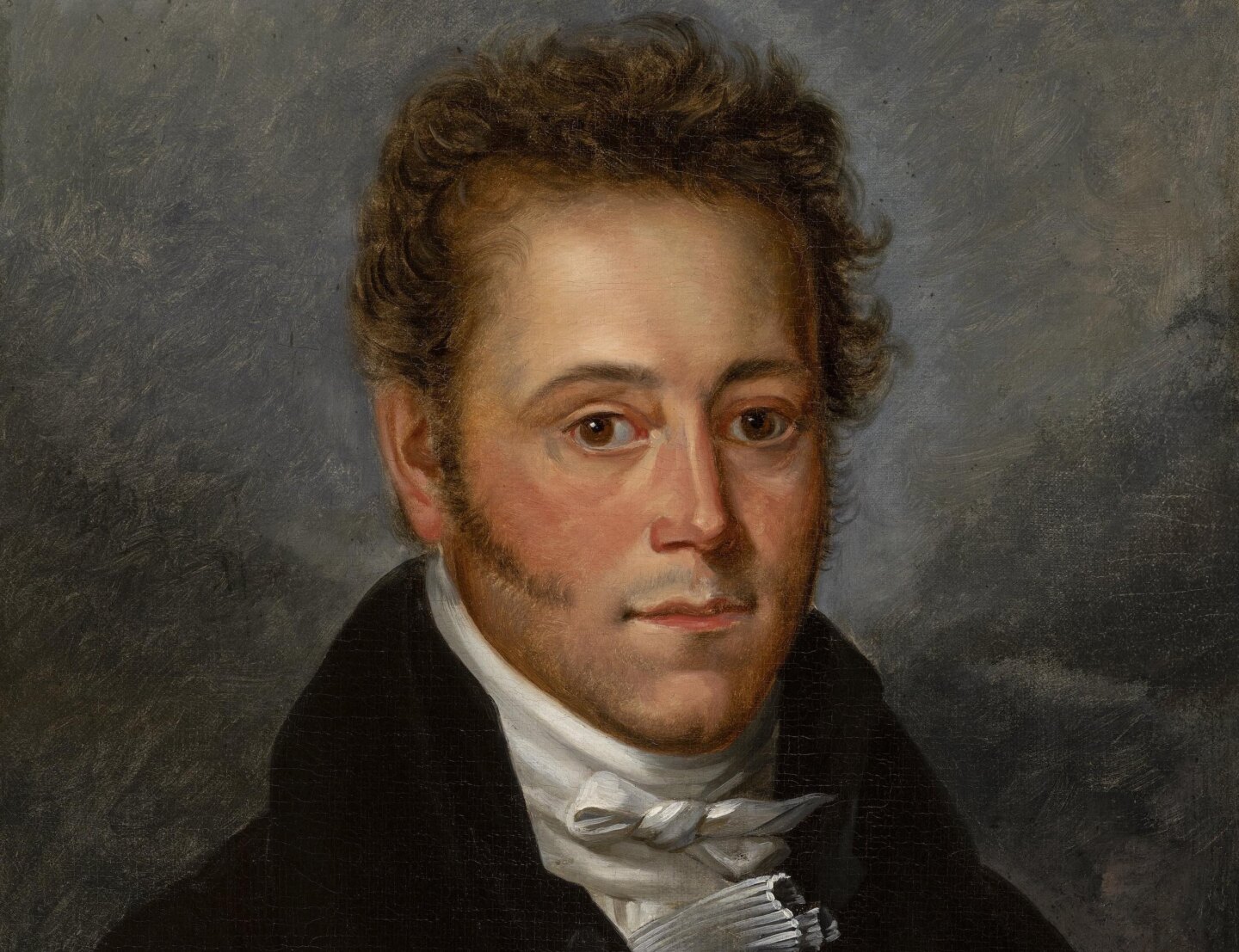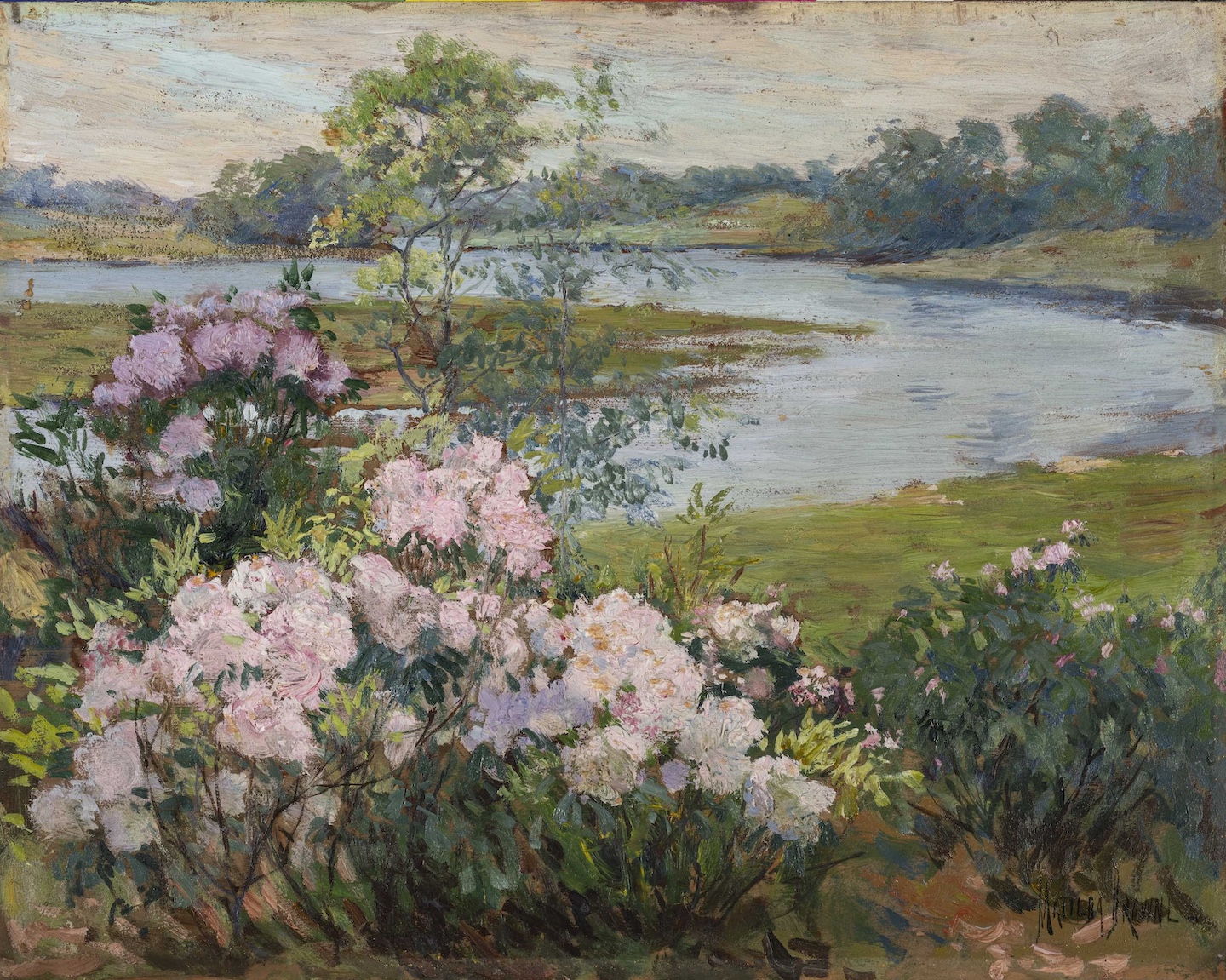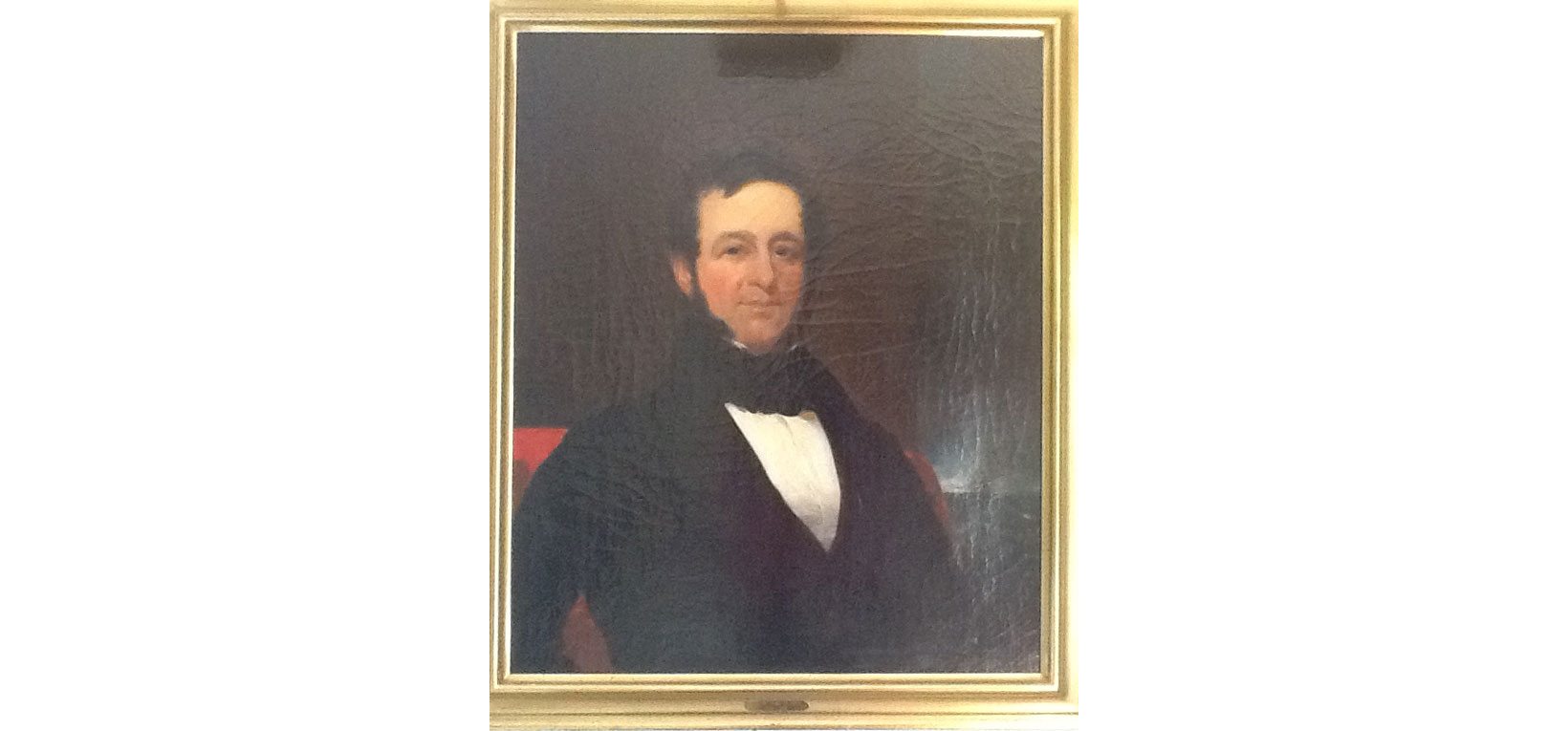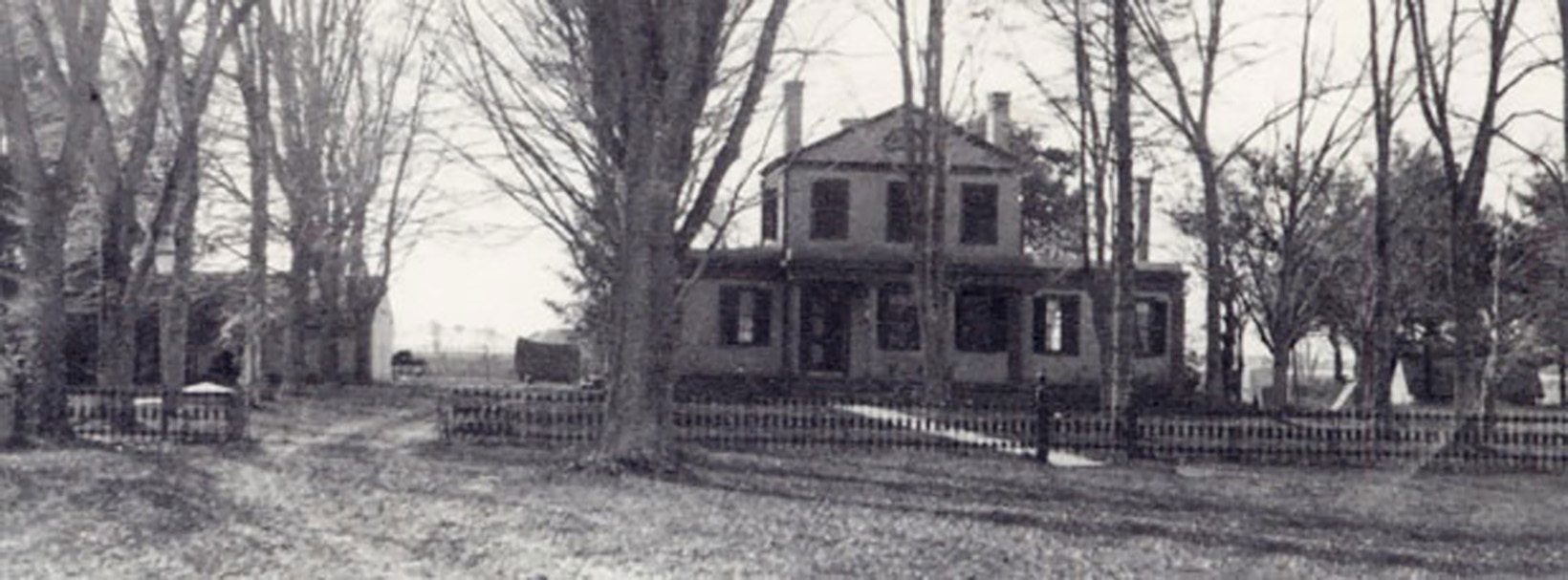
by Carolyn Wakeman
Feature Photo (above): Richard Sill Griswold, Jr., Marvin-Griffin house ca. 1890. LHSA
The distinctive house with pillared veranda at the foot of Lyme Street that historian Martha J. Lamb described in 1876 as a “modern” mansion[1] traces its origins to Albany. Erected for Benjamin Marvin, Jr. (1743–1823) ca. 1820, the two-story mid-section was built with lumber provided by his sons who had settled in the Hudson River Valley. The timbers, pre-cut in an Albany sawmill and shipped down the Hudson River, then across Long Island Sound,[2] were assembled just south of the village green on the site of an earlier family dwelling.[3]

Map detail, First (South) Society. J. David Little, Revolutionary Lyme: A Portrait, 1765-1783 (Old Lyme, 1976), p. 9.
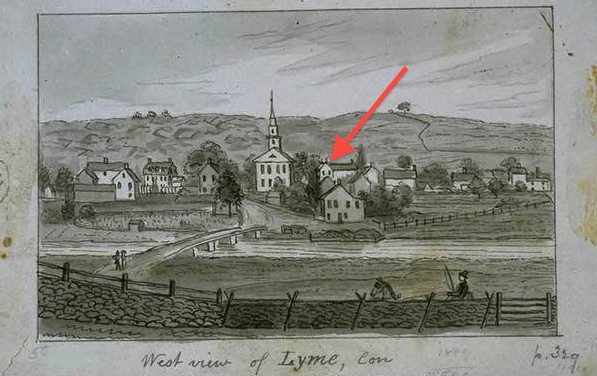
John Warner Barber, West View of Lyme, Connecticut, showing Parsons Tavern, 1838. Courtesy Connecticut Historical Society
Lyme Street was in 1820 a toll road operated by a private turnpike company and also a segment of the stagecoach route connecting New York and Boston.[4] After master architect Samuel Belcher completed a stately new Meetinghouse at the junction of the “highway” and the ferry road in 1817, the “church corner,” as it would later be called, became the center of the rural community. On the west side of the green, Parsons Tavern, a hotbed of civic dissent on the eve of the Revolution, stood between the Marvin house and the church. The busy tavern offered rest and refreshment to weary travelers; it also served as Lyme’s first post office.
The church had not yet moved from Meetinghouse Hill when five of Benjamin Marvin’s six sons, all born in the original family homestead, left Lyme to settle in Albany before 1805. Uriah, the eldest and first to leave, prospered in the dry goods trade,[5] joined by his brother Richard. William, John, and Alexander Marvin, who partnered in a successful grocery business on the corner of State and Quay Streets, would later rank “among the leading merchants of the city.” Uriah became a church elder, Richard and Alexander became bank directors, but John Marvin (1772–1853) retired from W. J. A. Marvin & Co. in 1822 at age 50 and returned to Lyme to assist their elderly father.[6]
Benjamin Marvin died the next year at age 79, soon after his new house was completed, and conveyed in his will his gratitude for John’s return: “And whereas my children and heirs are comfortably situated, and reside at a distance from me, except my son John Marvin, he having returned to live near me and assist me in the decline of life, I devise all my property to him.”[7] In 1832 John Marvin sold the forty acres of land “with two Dwelling houses, two barns &c. thereon” acquired from his father to Lyme merchant Stephen J. Lord (1797–1851) for $3,500. By then Marvin had returned to Albany where he died in 1853.[8]
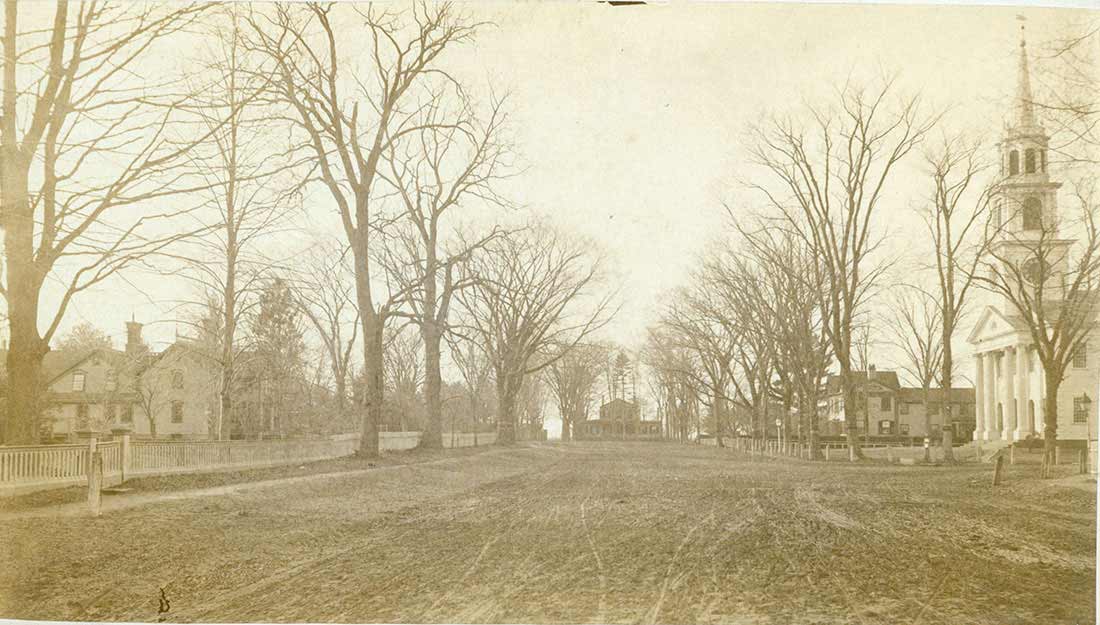
Richard Sill Griswold, Jr., Lyme Street, showing Marvin-Griffin house and McCurdy house, ca. 1895. Courtesy Ludington Family Collection

Detail East Front Parlor: Window Frame, 1960. From David C. Morton, “A Research Report on the Marvin-Griffin House, Old Lyme, Connecticut,” (unpublished paper, Yale University, 1960), p. 9. LHSA
Stephen Lord purchased the Marvin house, diagonally across the green from his wife’s birthplace, three years after marrying his first cousin Sarah Ann McCurdy (1807–1884). After the arrival of their fourth child in 1840, he enlarged and improved the family home, adding an elegant front porch with Greek Revival columns, paired side wings, and a rear extension.
Both the columns and the carved design on the door and window frames in the east parlor are identical to those in the mansion (later Boxwood Manor) that Richard Sill Griswold erected nearby, suggesting that decorative embellishments to the Lord home were made by the same builder.[9] But Stephen Lord had only a decade to enjoy his improved surroundings. In 1851 he died suddenly at age 54, leaving Sarah, aided by caring relatives and neighbors, to raise their youngest children.
In a profile of Lyme written forHarper’s New Monthly Magazine on the occasion of the American centennial in 1876, Martha Lamb noted the hybrid character of the house built originally for Benjamin Marvin. “To the south another mansion has spread itself squarely across the way,” she wrote. “It is high and broad, the front-door swings in the centre, and it has wings on the side and rear.” Comparing it to other more “antique” dwellings on the elm-lined street, she pronounced it “evidently a freak of modern independence.”[10]

Richard Sill Griswold, Jr., Mrs. Edward Dorr Griffin and Sarah Griffin, ca. 1895. LHSA
By then the house had passed to Stephen Lord’s daughter Gertrude McCurdy Lord (1840–1904) and her husband Dr. Edward Dorr Griffin (1840–1887), who opened a medical practice in town during the Civil War. From 1862 to 1884, a small room in the rear of the house served as Dr. Griffin’s office and apothecary, and his patients waited on a wooden bench just inside the kitchen door.[11] After his death Gertrude Griffin and her two daughters opened in 1893 a school for young boys in their home.
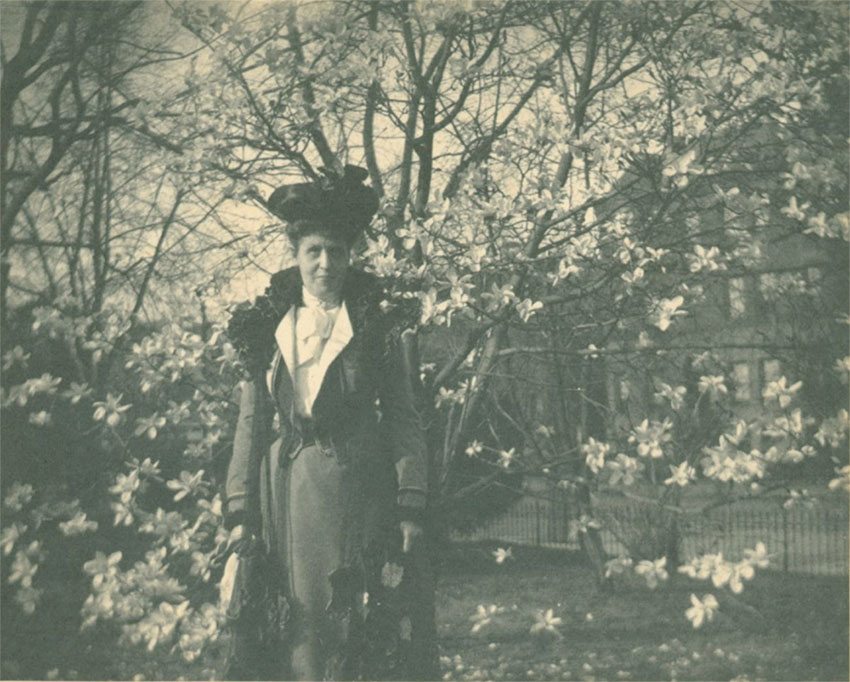
Augusta Griffin, ca. 1900. Ludington Photograph Album, LHSA
A promotional circular announced that the school sought “a limited number of boys, too young for the pressure and routine of ordinary boarding school life, and who need motherly care and watchful attention.” When Sarah Lord Griffin (1855–1933) married Horace Wells in 1896, her sister Augusta Nielson Griffin (1863–1926) directed the school, which charged $500 a year until it closed about 1898. The circular notes that: “the elementary studies are taught thoroughly, and Latin and French are begun.”[12]

Griffin Home School circular, ca. 1896. LHSA
For a century and a half the dwelling whose original timbers came from Albany remained in the Lord family, passing finally to Stephen Lord’s great-granddaughter, Mrs. Gertrude Wells Barney (1898–1991). Beloved by the community, Trudy Barney, a founding member of the Lyme Historical Society and over thirty years the secretary, vice-president, and president of the Phoebe Griffin Noyes Library, delighted in her gardens and her heirloom-filled home. “The rooms today have almost the aura of a museum,” wrote William Donoho in 1970 in Antiques Magazine. “The good contemporary furnishings that forward-looking Sarah Anne [Lord] acquired have become antiques as venerable as the old pieces she brought with her across the green.”[13]
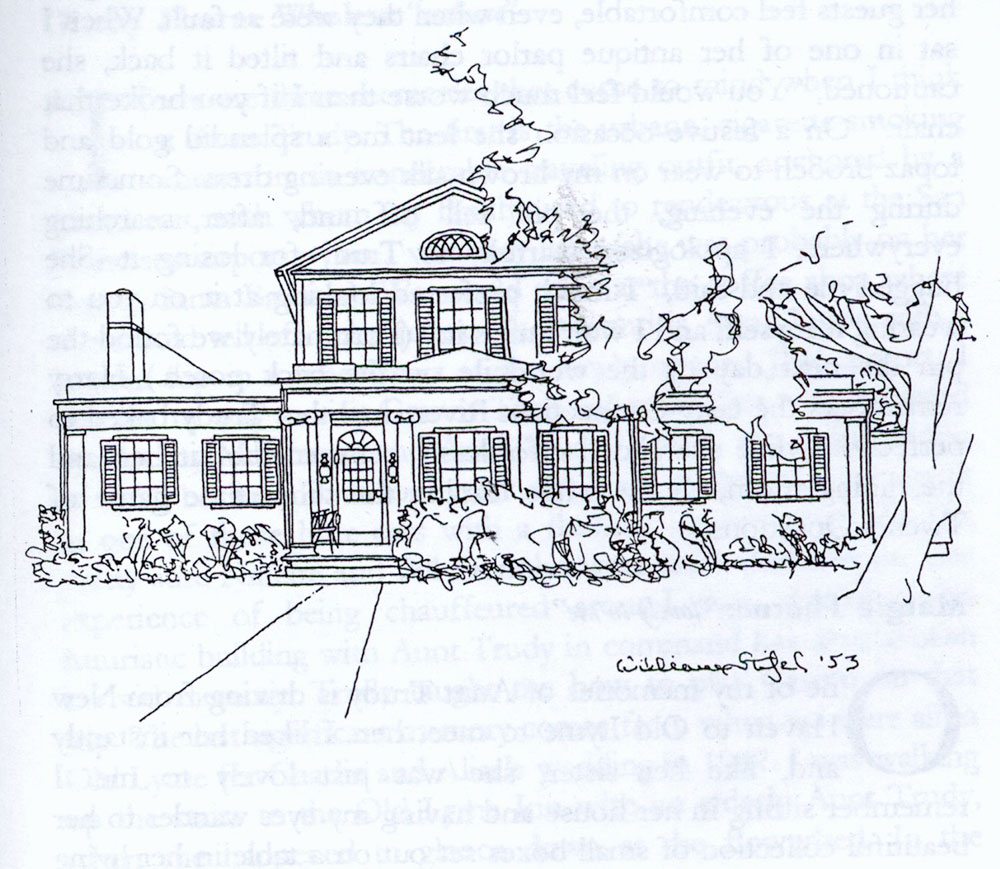
William Stifel, Marvin-Griffin house, drawing on paper, 1953.
From her attic Mrs. Barney would happily retrieve for relatives and townspeople whatever items they might need “in their most imaginative moments of planning wardrobes, costumes, home decoration, stage sets, or ‘happenings,” Donoho wrote. “‘It’s perfectly natural to have these things,” Mrs. Barney said. “You see, we have always lived here.”[14]

Library, Marvin-Griffin house, 1970. Antiques Magazine, December 1970, p. 924. Courtesy Geoffrey Paul
Today Christ the King Church and its parish center complex, completed in 2005 by award-winning New Haven architect Paul B. Bailey, occupy the former Marvin-Lord-Griffin-Barney sheep meadow. The house built nearly two centuries ago now serves as the monsignor’s residence and church rectory.[15]
[1] Martha J. Lamb, “Lyme: A Chapter of American Genealogy,” Harper’s New Monthly Magazine, Vol. LII (February 1876), p. 318, Lyme Historical Society Archives (LHSA), Monographs G-Lu.
[2] In Landmarks of Albany County, New York (Syracuse, 1897), p. 397, Amasa J. Parker notes that lumber from the two earliest Albany sawmills was loaded on sloops and sent down the river to New York and beyond. An architectural study of the house in 1960 found that the nine-inch walls are mostly filled with brick and concluded: “The presence of the brick makes any extensive prefabrication all the more doubtful.” See David C. Morton, “A Research Report on the Marvin-Griffin House, Old Lyme, Connecticut,” (unpublished paper, Yale University, 1960), p. 9, LHSA, Architecture Box 1, folder 31.
[3] The house was likely built between 1818, when Benjamin Marvin married as his second wife Abigail Smith of Lyme, and 1822 when his son John Marvin returned from Albany to assist his aging father.
[4] The New London-Lyme Turnpike Company, chartered in 1807, operated a toll highway from Bank Street in New London to the Connecticut River in Lyme “where it connected with the old Saybrook ferry, which had been in continuous operation since 1662, and over which the stages were carried… thence to New Haven.” See Frederic Wood, The Turnpikes of New England (Boston, 1919), pp. 379-80.
[5] Uriah Marvin (1770–1848) married Olive Ingraham (1774–1849) in 1794 in Lyme where their first son was born a year later, but their second son was born in Albany in 1797, followed by nine other children. A history of Schenectady states that Uriah “removed to Albany when a young man and engaged in mercantile business with his brother Richard. He became one of Albany’s prominent business men and leading citizens. He was an earnest friend of the cause of education and ruling elder of the Presbyterian church.” Source
[6] For biographical information about the Marvin brothers in Albany, see Gorham A. Worth, Random Recollections of Albany, from 1800 to 1808 (Albany, 1866), p. 47; Edward Salisbury and Evelyn McCurdy Salisbury, Family Histories and Genealogies (New Haven, 1892), I.1.168-9; III.132, 181-2.
[7] New London probate record VIII:452, cited in LHSA, Ely-Plimpton Papers, Box 5, Folder 1. On November 22, 1822, John paid his father $3,981.35 for “six several pieces of land,” one of which included a dwelling house, two barns, and other outbuildings. In a separate transaction on the same date, he sold the “six several pieces of land,” approximately 35 acres, for $500 back to his father. See Lyme Land Records (LLR) 30:136, 138.
[8] LLR 34:142. John Marvin had married in Albany in 1806 as his second wife Lucy Mather Lee, daughter of Ezra and Deborah Mather Lee of Lyme, and his five children were all born in Albany. His only daughter Emma Stevens Marvin (1805–1827) apparently moved with her parents to Lyme where she married in 1823 Samuel S. Fowler of Albany. Her burial four years later in the Duck River Cemetery suggests that her father still resided in Lyme in 1827. New York census records list one person named John Marvin, age between 50 and 59, living in Albany in 1830; Benjamin Marvin’s son would have been 58 that year.
[9] Morton, pp. 9, 13.
[10] Lamb, p. 318.
[11] Morton, p. 7. “Concerning Mrs. Gertrude McCurdy Griffin,” in Sarah Sill Welles Burt, Old Silltown: Something of Its History and People (1912), pp. 121-2. Katharine Ludington offers an affectionate description of “the pleasant house that stands on the green at the very end of the village street, spreading out wings on either side as if in welcome.” There she spent happy childhood hours escaping next door to the orchard or pine grove or “the little summerhouse almost hidden in shrubbery in the northeast corner of the Griffins’ yard.” See Lyme—And Our Family (Old Lyme, 1928), pp. 88-9.
[12] Griffin School circular, ca. 1896, LHSA, Architecture Box 1, folder 31. Like a circular for the Griswold Home School, printed about six years earlier with similar wording and style, the announcement for the Griffins’ school was probably provided by Evelyn McCurdy Salisbury (1823–1917), who repeatedly used her influence and resources to support educational efforts in Lyme.
[13] William T. Donoho, “Living with Antiques in Old Lyme, Conn.,” Antiques Magazine (December 1970), p. 923. Courtesy of Geoffrey Paul.
[14] Donoho, p. 923.


